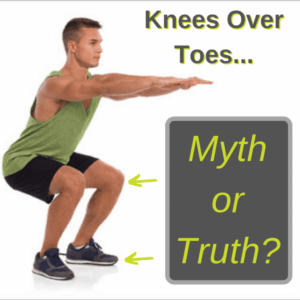
Have you ever been told not to let your your knees go over your toes? Whether it was in the gym or during other daily activities, most of us have heard the age old expression. We would like to take a more in-depth look into this saying and what it means on a functional level. Is it a myth… or does “knees over toes” have some truth to it?
Functionality: Can Your Knees Go Over Your Toes?
We have all heard the trainer in the gym or the sports coach tell someone not to let their knees go over their toes. While that may have once been a good cue, the phrase has been repeated so many times over the years it may now mean more than it was originally intended. The statement originated from a 1978 study at Duke University. The study provided us with some very important information at the time, but it only looked at one piece of the puzzle. A more recent, 2003 Memphis University study, took their research a little deeper and provided us with more up-to-date information on the topic.
So, can your knees go over your toes? As much as we would like definitive yes or no answer, the truth is: it depends. It depends on both your structure and the movement itself. Your structure plays the most important role in answering this question.
Structure
Everyone’s body is different. Something that may work for one person, may not be appropriate for another. Femur length, foot length, and torso length all determine the appropriate amount of forward translation demanded of the knee. Someone with longer femurs and shorter feet may naturally track over the toes. A shorter tibia/fibula length relative to femur length may naturally facilitate an anterior knee translation (see video from Stone Athletic Medicine). Torso length also plays a role in how the lower extremities flex through movement. Check out this picture shared by Zach Long, DPT SCS Cert.CMFA, for a visual representation. As the referenced study above by Fry, Smith, and Schilling reported in the Journal of Strength and Conditioning Research, when blocking the knees, we reduce torque by 22% at the knee joint but increase torque at the hips by 1,070%, regardless of structure.
Movement
In a gym setting, different types of activities and movements may or may not result in your knees travelling over the toes. Different bar placement, or load placement, will facilitate different hip and knee joint angles. For instance, a low barbell back squat places the barbell lower on the back and pushes the hips back further. This will make the movement more hip dominant. However, if we place the load in front of the body, like in a barbell front squat, we create a more quadricep dominant movement. The knees will move more forward, out over the toes, and the chest will be more upright. Read this article from Squat University to delve deeper into the bio-mechanics of different squats.
Knees Over Toes: In Real Life
Let’s look at a few movements we do on a regular basis. These may not be considered ‘daily activities,’ but our bodies typically do these movements with no issue.
Ascending and Descending
Our bodies are designed to navigate various different types of terrain. One typical type of terrain we regularly navigate are hills. The world around us varies in height and distance. While walking up, and most certainly down hills, our knees naturally translate over our toes to support our body weight. Another great example of this are stairs. Depending upon stair height and stride distance, we may or may not track over our toes while ascending stairs; however, have you ever tried to go down stairs without your knee going over our toes? It’s nearly impossible unless you set your hips back drastically or pistol squat every step of the way. Go ahead; give it a try!
Bicycle
Another fun activity we often do is bicycle. This may not be a daily activity, but it is most certainly one many of us participate in on a regular basis. We do this at the gym, with our children, and sometimes as our primary means of transportation. It is important to make sure our seat height is set properly, but no matter the positioning, knees typically go over the toes while in the pushing phase of cycling. There is nothing inherently wrong with any of this because our bodies are made to move this way!
Resiliency
Resiliency is the name of the game. Our bodies are resilient and are not as fragile as we may sometimes be told. We are made to move about our space functionally, in multiple planes, with no issues. Sometimes our knees need to go over our toes, and sometimes they don’t. Take charge, and keep moving! Motion is lotion and makes for great longevity in life!
If you want to prevent injury, come visit one of our Wellness Coordinators for a professional opinion on your squat form. We would love to chat with you! Or, are you experiencing pain when squatting? Schedule an appointment with one of our Physical Therapists to resolve any issues before they become worse!

